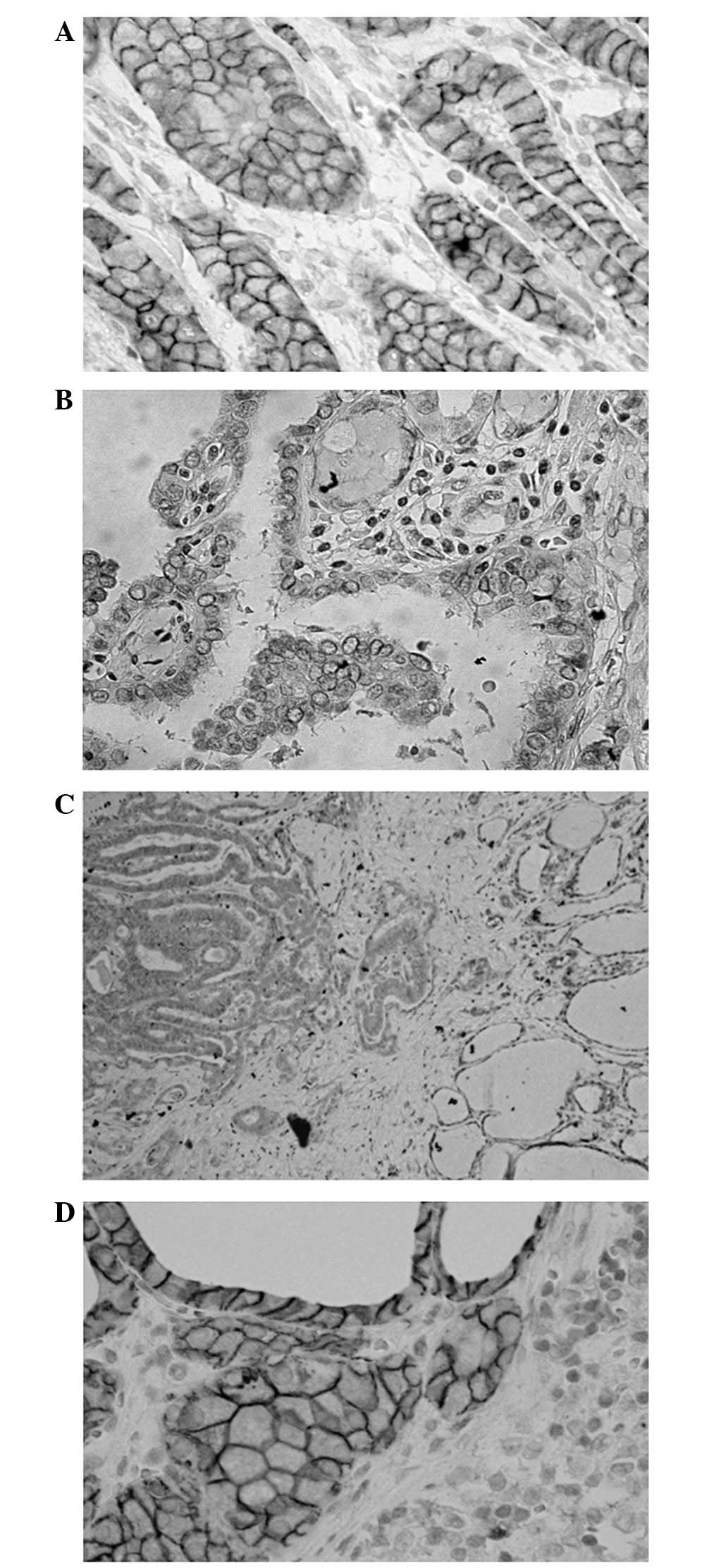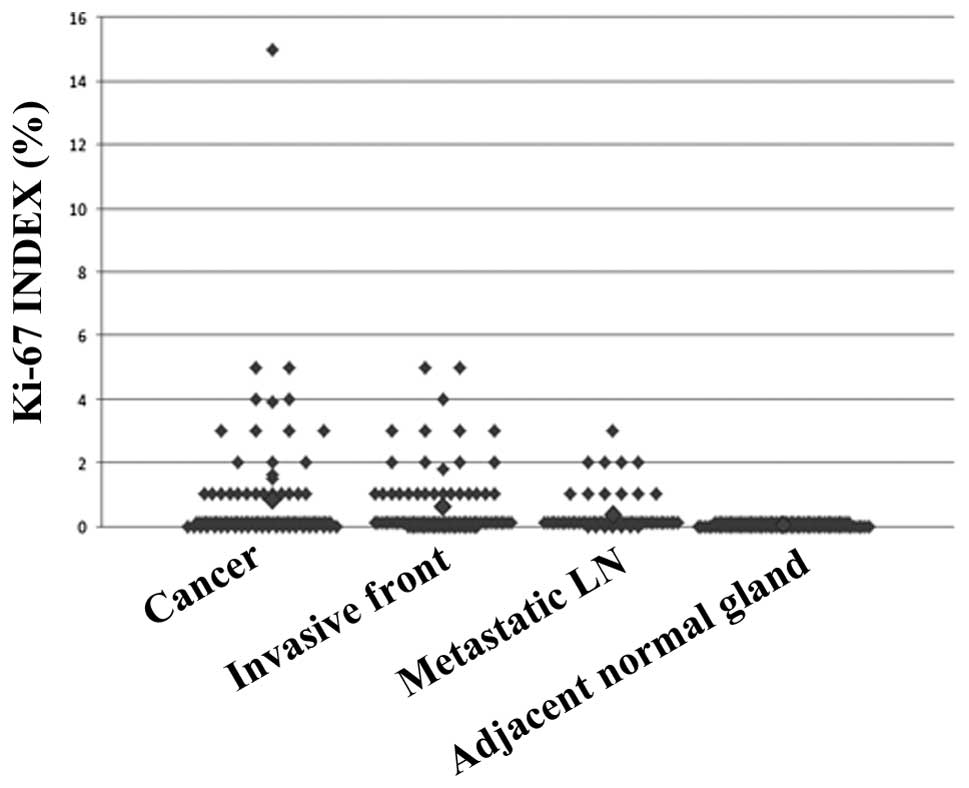|
1
|
LiVolsi VA, Albores-Saavedra J, Asa SL, et
al: Papillary carcinoma. World Health Organization Classification
of Tumours: Pathology and Genetics. Tumours of the Endocrine
Organs. De Lellis RA, Lloyd RV, Heitz PU and Eng C: 8. IARC Press
International Agency for Research on Cancer; Lyon: pp. 57–66.
2004
|
|
2
|
Leenhardt L, Grosclaude P and
Chérié-Challine L; Thyroid Cancer Committee. Increased incidence of
thyroid carcinoma in France: a true epidemic or thyroid nodule
management effects? Report from the French Thyroid Cancer
Committee. Thyroid. 14:1056–1060. 2004. View Article : Google Scholar
|
|
3
|
Chow SM, Law SC, Chan JK, et al: Papillary
microcarcinoma of the thyroid - Prognostic significance of lymph
node metastasis and multifocality. Cancer. 98:31–40. 2003.
View Article : Google Scholar : PubMed/NCBI
|
|
4
|
Hay ID, Hutchinson ME, Gonzalez-Losada T,
et al: Papillary thyroid microcarcinoma: a study of 900 cases
observed in a 60-year period. Surgery. 144:980–988. 2008.PubMed/NCBI
|
|
5
|
Karatzas T, Vasileiadis I, Kapetanakis S,
et al: Risk factors contributing to the difference in prognosis for
papillary versus micropapillary thyroid carcinoma. Am J Surg.
206:586–593. 2013. View Article : Google Scholar : PubMed/NCBI
|
|
6
|
Roti E, degli Uberti EC, Bondanelli M and
Braverman LE: Thyroid papillary microcarcinoma: a descriptive and
meta-analysis study. Eur J Endocrinol. 159:659–673. 2008.
View Article : Google Scholar : PubMed/NCBI
|
|
7
|
Sugitani I, Toda K, Yamada K, et al: Three
distinctly different kinds of papillary thyroid microcarcinoma
should be recognized: our treatment strategies and outcomes. World
J Surg. 34:1222–1231. 2010. View Article : Google Scholar
|
|
8
|
Buffet C, Golmard JL, Hoang C, et al:
Scoring system for predicting recurrences in patients with
papillary thyroid microcarcinoma. Eur J Endocrinol. 167:267–275.
2012.PubMed/NCBI
|
|
9
|
Riss JC, Peyrottes I, Chamorey E, et al:
Prognostic impact of tumour multifocality in thyroid papillary
microcarcinoma based on a series of 160 cases. Eur Ann
Otorhinolaryngol Head Neck Dis. 129:175–178. 2012. View Article : Google Scholar : PubMed/NCBI
|
|
10
|
Hay ID, Grant CS, van Heerden JA, et al:
Papillary thyroid microcarcinoma: a study of 535 cases observed in
a 50-year period. Surgery. 112:1139–1147. 1992.PubMed/NCBI
|
|
11
|
Pisanu A, Reccia I, Nardello O and
Uccheddu A: Risk factors for nodal metastasis and recurrence among
patients with papillary thyroid microcarcinoma: differences in
clinical relevance between nonincidental and incidental tumors.
World J Surg. 33:460–468. 2009. View Article : Google Scholar
|
|
12
|
Zheng X, Wei S, Han Y, et al: Papillary
microcarcinoma of the thyroid: clinical characteristics and
BRAF(V600E) mutational status of 977 cases. Ann Surg Oncol.
20:2266–2273. 2013. View Article : Google Scholar : PubMed/NCBI
|
|
13
|
Gulben K, Berberoglu U, Celen O and Mersin
HH: Incidental papillary microcarcinoma of the thyroid - factors
affecting lymph node metastasis. Langenbecks Arch Surg. 393:25–29.
2008. View Article : Google Scholar : PubMed/NCBI
|
|
14
|
Sugitani I, Yanagisawa A, Shimizu A, Kato
M and Fujimoto Y: Clinicopathologic and immunohistochemical studies
of papillary thyroid microcarcinoma presenting with cervical
lymphadenopathy. World J Surg. 22:731–737. 1998. View Article : Google Scholar : PubMed/NCBI
|
|
15
|
Zhang L, Wei WJ, Ji QH, et al: Risk
factors for neck nodal metastasis in papillary thyroid
microcarcinoma: a study of 1066 patients. J Clin Endocrinol Metab.
97:1250–1257. 2012. View Article : Google Scholar : PubMed/NCBI
|
|
16
|
Hyun SM, Song HY, Kim SY, et al: Impact of
combined prophylactic unilateral central neck dissection and
hemithyroidectomy in patients with papillary thyroid
microcarcinoma. Ann Surg Oncol. 19:591–596. 2012. View Article : Google Scholar : PubMed/NCBI
|
|
17
|
Caliskan M, Park JH, Jeong JS, et al: Role
of prophylactic ipsilateral central compartment lymph node
dissection in papillary thyroid microcarcinoma. Endocr J.
59:305–311. 2012. View Article : Google Scholar : PubMed/NCBI
|
|
18
|
Zeng RC, Li Q, Lin KL, et al: Predicting
the factors of lateral lymph node metastasis in papillary
microcarcinoma of the thyroid in eastern China. Clin Transl Oncol.
14:842–847. 2012. View Article : Google Scholar : PubMed/NCBI
|
|
19
|
Zhou YL, Gao EL, Zhang W, et al: Factors
predictive of papillary thyroid micro-carcinoma with bilateral
involvement and central lymph node metastasis: a retrospective
study. World J Surg Oncol. 10:672012. View Article : Google Scholar : PubMed/NCBI
|
|
20
|
Kim BY, Jung CH, Kim JW, et al: Impact of
clinicopathologic factors on subclinical central lymph node
metastasis in papillary thyroid microcarcinoma. Yonsei Med J.
53:924–930. 2012. View Article : Google Scholar : PubMed/NCBI
|
|
21
|
Sugitani I and Fujimoto Y: Management of
low-risk papillary thyroid carcinoma: unique conventional policy in
Japan and our efforts to improve the level of evidence. Surg Today.
40:199–215. 2010. View Article : Google Scholar : PubMed/NCBI
|
|
22
|
Kalluri R and Weinberg RA: The basics of
epithelial-mesenchymal transition. J Clin Invest. 119:1420–1428.
2009. View
Article : Google Scholar : PubMed/NCBI
|
|
23
|
Batistatou A, Charalabopoulos K, Nakanishi
Y, et al: Differential expression of dysadherin in papillary
thyroid carcinoma and microcarcinoma: correlation with E-cadherin.
Endocr Pathol. 19:197–202. 2008. View Article : Google Scholar : PubMed/NCBI
|
|
24
|
Choi YL, Kim MK, Suh JW, et al:
Immunoexpression of HBME-1, high molecular weight cytokeratin,
cytokeratin 19, thyroid transcription factor-1, and E-cadherin in
thyroid carcinomas. J Korean Med Sci. 20:853–859. 2005. View Article : Google Scholar : PubMed/NCBI
|
|
25
|
Naito A, Iwase H, Kuzushima T, Nakamura T
and Kobayashi S: Clinical significance of E-cadherin expression in
thyroid neoplasms. J Surg Oncol. 76:176–180. 2001. View Article : Google Scholar : PubMed/NCBI
|
|
26
|
Kapran Y, Ozbey N, Molvalilar S, et al:
Immunohistochemical detection of E-cadherin, alpha- and
beta-catenins in papillary thyroid carcinoma. J Endocrinol Invest.
25:578–585. 2002. View Article : Google Scholar : PubMed/NCBI
|
|
27
|
von Wasielewski R, Rhein A, Werner M, et
al: Immunohistochemical detection of E-cadherin in differentiated
thyroid carcinomas correlates with clinical outcome. Cancer Res.
57:2501–2507. 1997.PubMed/NCBI
|
|
28
|
Kashiwagi S, Yashiro M, Takashima T, et
al: c-Kit expression as a prognostic molecular marker in patients
with basal-like breast cancer. Br J Surg. 100:490–496. 2013.
View Article : Google Scholar : PubMed/NCBI
|
|
29
|
Liu Z, Kakudo K, Bai Y, et al: Loss of
cellular polarity/cohesiveness in the invasive front of papillary
thyroid carcinoma, a novel predictor for lymph node metastasis;
possible morphological indicator of epithelial mesenchymal
transition. J Clin Pathol. 64:325–329. 2011. View Article : Google Scholar
|
|
30
|
Pelizzo MR, Boschin IM, Toniato A, et al:
Natural history, diagnosis, treatment and outcome of papillary
thyroid microcarcinoma (PTMC): a mono-institutional 12-year
experience. Nucl Med Commun. 25:547–552. 2004.PubMed/NCBI
|
|
31
|
Lee J, Park JH, Lee CR, Chung WY and Park
CS: Long-term outcomes of total thyroidectomy versus thyroid
lobectomy for papillary thyroid microcarcinoma: comparative
analysis after propensity score matching. Thyroid. 23:1408–1415.
2013. View Article : Google Scholar
|
|
32
|
Pacini F: Management of papillary thyroid
microcarcinoma: primum non nocere! J Clin Endocrinol Metab.
98:1391–1393. 2013.PubMed/NCBI
|
|
33
|
Ito Y, Tomoda C, Uruno T, et al: Papillary
microcarcinoma of the thyroid: how should it be treated? World J
Surg. 28:1115–1121. 2004. View Article : Google Scholar : PubMed/NCBI
|
|
34
|
Ito Y, Uruno T, Nakano K, et al: An
observation trial without surgical treatment in patients with
papillary microcarcinoma of the thyroid. Thyroid. 13:381–387. 2003.
View Article : Google Scholar : PubMed/NCBI
|
|
35
|
Sugitani I and Fujimoto Y: Symptomatic
versus asymptomatic papillary thyroid microcarcinoma: a
retrospective analysis of surgical outcome and prognostic factors.
Endocr J. 46:209–216. 1999. View Article : Google Scholar : PubMed/NCBI
|
|
36
|
Yu XM, Wan Y, Sippel RS and Chen H: Should
all papillary thyroid microcarcinomas be aggressively treated? An
analysis of 18,445 cases. Ann Surg. 254:653–660. 2011. View Article : Google Scholar : PubMed/NCBI
|
|
37
|
Hugo H, Ackland ML, Blick T, et al:
Epithelial - mesenchymal and mesenchymal - epithelial transitions
in carcinoma progression. J Cell Physiol. 213:374–383. 2007.
View Article : Google Scholar : PubMed/NCBI
|
|
38
|
Vasko V, Espinosa AV, Scouten W, et al:
Gene expression and functional evidence of
epithelial-to-mesenchymal transition in papillary thyroid carcinoma
invasion. Proc Natl Acad Sci USA. 104:2803–2808. 2007. View Article : Google Scholar : PubMed/NCBI
|
|
39
|
Zeisberg M and Neilson EG: Biomarkers for
epithelial-mesenchymal transitions. J Clin Invest. 119:1429–1437.
2009. View
Article : Google Scholar : PubMed/NCBI
|
|
40
|
Knauf JA, Sartor MA, Medvedovic M, et al:
Progression of BRAF-induced thyroid cancer is associated with
epithelial-mesenchymal transition requiring concomitant MAP kinase
and TGFβ signaling. Oncogene. 30:3153–3162. 2011.PubMed/NCBI
|
|
41
|
Virk RK, Van Dyke AL, Finkelstein A, et
al: BRAFV600E mutation in papillary thyroid microcarcinoma: a
genotype-phenotype correlation. Mod Pathol. 26:62–70. 2013.
View Article : Google Scholar : PubMed/NCBI
|
|
42
|
So YK, Son YI, Baek CH, et al: Expression
of sodium-iodide symporter and TSH receptor in subclinical
metastatic lymph nodes of papillary thyroid microcarcinoma. Ann
Surg Oncol. 19:990–995. 2012. View Article : Google Scholar : PubMed/NCBI
|
|
43
|
Kim HJ, Kim NK, Choi JH, et al:
Radioactive iodine ablation does not prevent recurrences in
patients with papillary thyroid microcarcinoma. Clin Endocrinol
(Oxf). 78:614–620. 2012. View Article : Google Scholar : PubMed/NCBI
|











